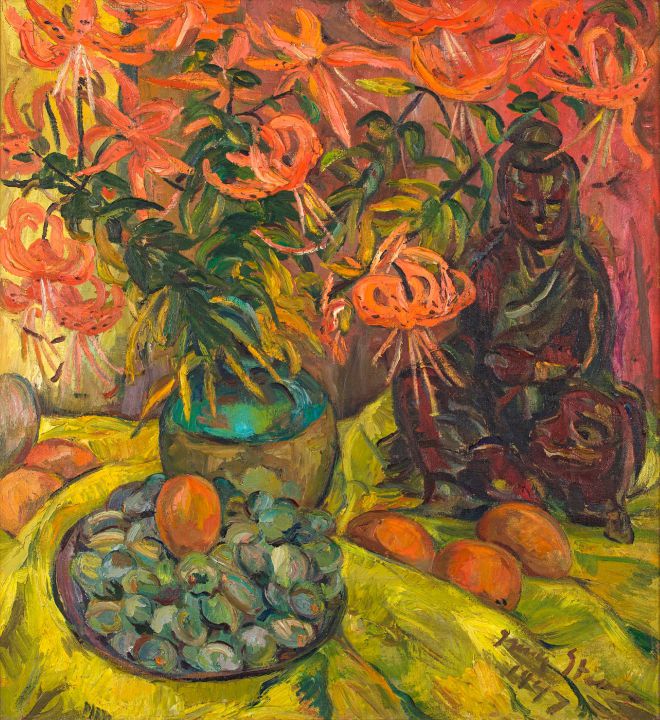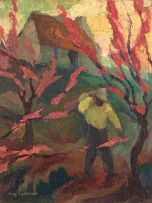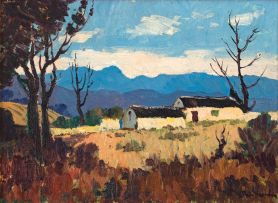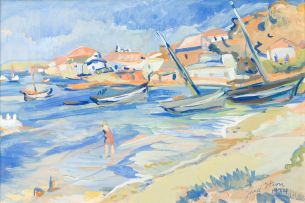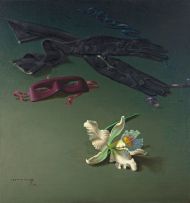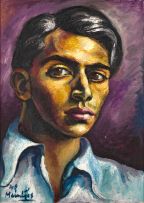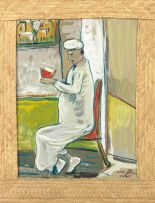Important South African & International Art, Decorative Arts & Jewellery
Live Auction, 10 October 2016
Important South African & International Art
Incl. Buyer's Premium & VAT
About this Item
signed and dated 1947
Notes
Irma Stern painted still-life scenes throughout her prolific career. These compositions served an important function in relation to her overall practice. "She did not attain the fluent and evocative style that characterizes her mature paintings, from about 1935, without effort," writes art historian Marion Arnold. "Object painting enabled her both to experiment with paint application and to determine how she related to empirical reality. The physicality of objects - their materials, surfaces and forms - presented a challenge: description had to be balanced with expression."1 Stern would also use the genre of still life as a "testing ground for colour experiments", writes Arnold. Given the preponderance of figurative elements - here a Buddha sculpture - it is possible to infer a relationship with her understanding of the human form too. These formal considerations are, though, subsumed by a bias against botanical still lifes. The genre, writes Arnold, is viewed as a "popular, light-weight, purely decorative art".2 Arnold has argued for a reappraisal of Stern's floral still lifes, stating that they possess diverse meanings related to commercial enterprise and the ecology.3 Stern's choice of ornamental tiger lilies in this painting is instructive. Tiger lilies flower in shades from salmon-orange to orange-red in late summer and autumn. They are not indigenous to South Africa. Their exuberant flowers are unlike the delicate blooms of the Southern Cape. Their "untidy leaf structure" and "wonderful abundance" were, however, perfectly suited to Stern's expressive style of painting.4 Emil Nolde, an important German-Danish painter and member of Die Brücke group of expressionist painters, also painted tiger lilies. Nolde's reputation was partly staked on the "storms of colour" his works presented, which is an appropriate description for this brilliantly coloured canvas too. The vessels and objects in Still Life with Lilies merit description. The vase, a partly glazed Chinese storage jar thought to date from the Yuan dynasty, formed part of Irma Stern's personal collection. The Buddha figure, however, is of unknown provenance. It was not listed in the sale of Stern's estate at Ashbey's Galleries in 1968. It is thought to have been disposed of earlier, or may have been loaned. Stern collected widely and her collection included several other Buddha statues, as well as religious artefacts from Africa, Asia and Europe. Stern attributed aesthetic - rather than religious - significance to these objects. Mona Berman writes: "Irma's eclectic but priceless collection had nothing to do with her religious beliefs or absence of them. She acquired the artworks as an artist and a collector, not for their religious associations."5 Strauss & Co achieved a record price for a Stern still life with Gladioli (1939). The lot sold in 2010 for R12 million (hammer price).
- Marion I. Arnold. (1995) Irma Stern: A Feast for the Eye, Cape Town: Fernwood Press. Page 139.
- Marion I. Arnold. (2001) 'Petals and Stigmas', in South African Botanical Art, Cape Town: Fernwood. Page 148.
- Ibid. Page 148.
- Interview with Christopher Peter, Director, Irma Stern Museum, 25 August 2016.
- Mona Berman. (2003) Remembering Irma: Irma Stern: A Memoir with Letters, Cape Town: Double Storey Books. Page 136.
Provenance
A gift from the artist to her brother Rudi Stern, and thence by descent
Literature
Marion Arnold. (1995) Irma Stern: A Feast for the Eye, Cape Town: Fernwood Press. Illustrated in colour on page 145.
